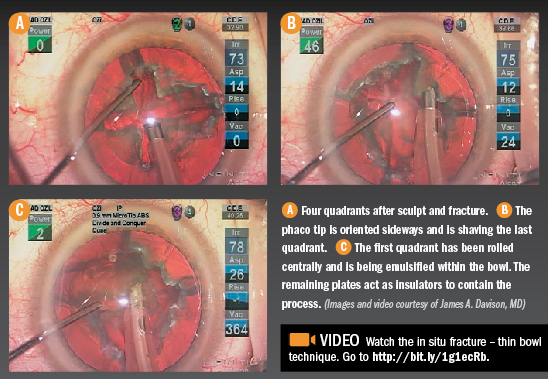Article
In situ sculpting makes surgery safer for hard cataracts
The in situ fracture – thin bowl technique is designed to reduce the risk of corneal endothelial damage when removing hard cataracts. Clinical study data show that it works.
TAKE HOME:
The in situ fracture – thin bowl technique is designed to reduce the risk of corneal endothelial damage when removing hard cataracts. Clinical study data show that it works.
By Cheryl Guttman Krader; Reviewed by James A. Davison, MD, FACS
Marshalltown, IA-The in situ fracture – thin bowl technique is a safe and effective method for removing hard cataracts, according to James A. Davison, MD, FACS.
The approach uses longitudinal phacoemulsification to groove the nucleus as per a divide-and-conquer technique, according to Dr. Davison, who specializes in cataract and refractive surgery at the Wolfe Eye Clinic, Marshalltown, IA.
However, while still working within the capsular bag, the surgeon continues to sculpt the nucleus into a thin bowl, creating two-dimensional plates that are drawn into the anterior central bowl for removal using either longitudinal phacoemulsification or a torsional/vacuum triggered longitudinal strategy.
Surgery for hard cataracts using the in situ fracture – thin bowl technique has been associated with few complications and a lower endothelial cell loss rate compared with the chop technique, which is popular with about half of surgeons in the United States, Dr. Davison said.
“Many surgeons routinely use the chop technique, but that may be a disadvantaged approach with hard cataracts. It brings large chunks of hard nuclear material up into the iris plane and anterior chamber where it can abrade the corneal endothelium,” Dr. Davison said.
“Reducing the nucleus to thin plates first before centralizing the material in the higher vacuum and aspiration rate quadrant removal mode makes surgery for hard cataracts, faster, easier, and ultimately healthier for the eye,” he added.

Evaluation of technique
To evaluate the in situ fracture – thin bowl technique, Dr. Davison conducted a prospective study that included 56 consecutive eyes with hard cataract (LOCS III NC > 3.8). Surgery was performed using a phacoemulsification platform (Infiniti Vision System, Alcon Laboratories) through a 2.4-mm incision.
The in situ fracture – thin bowl technique was used in all cases, but the eyes were randomly assigned to quadrant removal using either a longitudinal tip motion or a torsional/vacuum triggered longitudinal tip motion (OZil Intelligent Phaco, Alcon).
Outcomes assessed included intraoperative complications and change in endothelial cell density (ECD) measurements from preoperative to 3 months after surgery.
The only intraoperative complication in the study was the development of a whitened thermal effect at the corneal incision in one eye that underwent quadrant removal with longitudinal tip motion, and the incision was closed at the end of the case with a single “X” pattern 10-0 nylon suture.
At 3 months after surgery, the mean % decrease in corneal ECD was 5.9% for the longitudinal group and 2.7% for the torsional/vacuum triggered longitudinal group, which was a statistically insignificant difference.
“However, the outcome in both groups compares very favorably with other techniques for removing hard cataracts,” said Dr. Davison, citing a previous study in which ECD decreased 15.7% among eyes with hard cataracts operated on with a chop technique.
James A. Davison, MD
Dr. Davison is a paid consultant to Alcon Laboratories, but has no financial interest in any of the devices or techniques presented.
Subscribe to Ophthalmology Times to receive the latest clinical news and updates for ophthalmologists.
Newsletter
Don’t miss out—get Ophthalmology Times updates on the latest clinical advancements and expert interviews, straight to your inbox.





